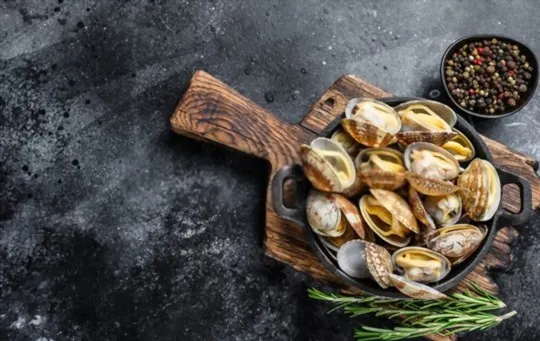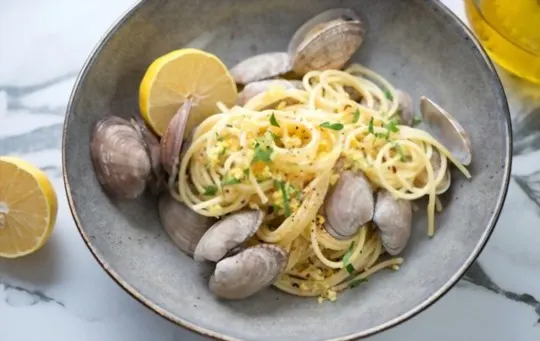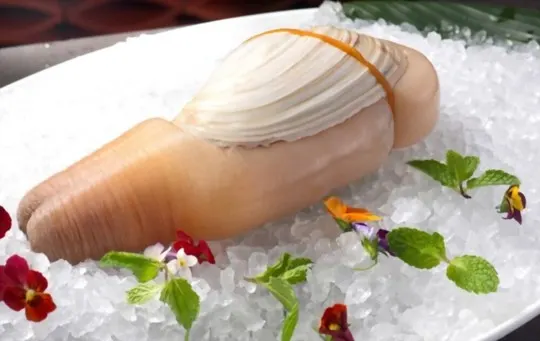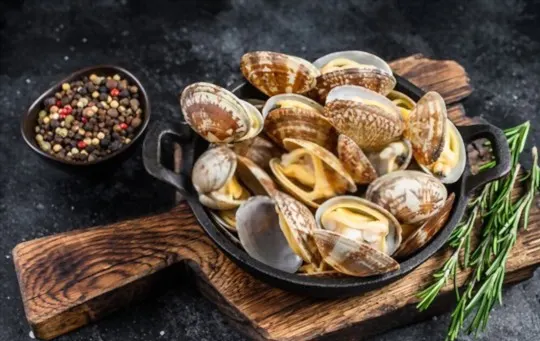Clams are one of the most popular seafood dishes in the world, enjoyed by people from all walks of life.
Yet, so many have never been able to answer that age-old question—what do clams actually taste like?
Even if you’ve had them at a restaurant or tried out a few recipes at home, it can be hard to really define what makes this delicious delicacy so special.
In this comprehensive guide, we’ll dive deep into dissecting the flavor profile of clams and detail how best to enjoy them.
Whether you want to learn about different types for cooking or just understand why they taste great on their own – prepare yourself for an exploration filled with gastronomic potential!
What are Clams?

Clams are a type of seafood that live in sand or mud and belong to the mollusk family.
They can be found in both freshwater and saltwater habitats, and there are thousands of different species worldwide.
Clams have a hard shell with two hinged parts that can be opened and closed.
Inside the shell is the soft animal part of the clam, which is eaten as food.
As mentioned earlier, clams come in many different varieties such as cherrystone clams, littleneck clams, quahogs, steamers etc.
These variations differ in size, taste and texture.
Generally speaking though, these bivalves have a tender texture with a chewy bite.
The meat inside ranges from ivory to light tan or grayish-brown.
Depending on their origin – ocean or freshwater – they can have varying levels of brininess/ saltiness.
Clam meat is rich in nutrients like protein and minerals such as iron and zinc which makes it highly nutritious.
It’s also low in fat making it a healthy choice for seafood lovers looking for options that are high in omega-3 fatty acids without all the calories usually found with such foods.
This versatile ingredient can be used raw, steamed, sauteed, fried, grilled, smoked or roasted depending on your recipe preference.
What Do Clams Taste Like?

Clams are a type of shellfish that people enjoy eating around the world.
When it comes to their taste, clams have a distinct and delicious flavor that is unique to them.
They tend to be quite salty, which many people enjoy, but they also have a subtle sweetness to them that balances out that saltiness.
Additionally, they have a tender texture and can be eaten raw or cooked in a variety of ways.
If you are someone who has never tried clams before, it can be challenging to imagine what they might taste like.
The best way to describe their flavor is to say that they are briny and slightly sweet with a meaty texture that makes them very satisfying to eat.
Some people even compare the taste of clams to the ocean itself, as they capture the essence of the sea in every bite.
When cooked, clams take on an even more complex flavor profile.
Depending on how they are prepared, they can either have a subtle buttery taste or take on bold flavors from herbs and spices.
One popular way to eat clams is in chowder, where their taste blends with other ingredients such as potatoes and cream for a rich and satisfying dish.
Overall, if you are someone who enjoys seafood and isn’t afraid of trying new things, clams are definitely worth adding to your list.
With their unique combination of sweetness and saltiness along with their tender texture, they offer a taste experience unlike any other.
Types of Clams and Their Flavor Profiles
Clams are a type of bivalve mollusk commonly found in both freshwater and saltwater habitats.
They have been consumed for centuries across the world due to their high nutritional value and unique flavor profiles.
The first type of clam we’ll cover is the Quahog clam which is famous for its large size and chewy texture.
These hard-shelled clams offer a bold briny aroma that screams freshness from the ocean floor.
With its sharp taste, it’s no wonder why quahogs are often consumed raw on the half shell or smoked using hickory wood chips for added flavor depth.
1 – Quahog Clams
Quahog clams are a type of hard-shell clam that is commonly found off the coast of New England.
These clams have a distinct flavor that is often described as being briny and slightly sweet.
They are also quite meaty, with a firm texture that can be quite satisfying to bite into.
When it comes to cooking quahogs, they are often used in dishes such as clam chowder or stuffed clams.
Due to their firmness, quahogs hold up well in soups and stews, and also work well when grilled or sautéed.
If you are looking for a seafood dish with a strong coastal flavor, quahog clams may be just what you need.
Whether you enjoy them as part of a hearty soup or grilled to perfection, these flavorful clams will certainly not disappoint.
Overall, quahogs are a unique type of clam with plenty of flavor and versatility when it comes to cooking.
If you haven’t tried them yet, don’t hesitate to give them a try.
2 – Littleneck Clams

Littleneck Clams are a type of clam that are smaller in size compared to Quahog Clams.
They are typically found on the Atlantic coast of North America, from Canada to Florida.
When it comes to taste, Littleneck Clams have a slightly sweet and briny flavor with a firm texture.
They can be prepared raw, steamed or even added to pasta dishes.
In comparison to Quahog Clams which are larger and firmer in texture with a more pronounced briny taste, Littleneck Clams are generally more tender and sweeter.
If you’re looking for a versatile ingredient that adds delicious flavor and texture to your dishes, try using Littleneck Clams in your next recipe.
3 – Razor Clams
Razor clams are a type of clam that are known for their long, thin shells and elongated shape.
These clams can be found along sandy beaches, estuaries, and mudflats in the Pacific Northwest region of North America.
If you’ve never tried razor clams before, you’re missing out on a true delicacy.
When it comes to taste, razor clams are similar to other types of clams but do have a unique flavor all their own.
They have a sweet and briny taste with a slightly chewy texture.
Some people describe it as tasting like the ocean – salty and fresh.
Cooking methods vary, but steaming or frying them is a popular choice.
Razor clams can be enjoyed in many different ways including chowders, fritters or simply served with bread and butter.
They’re also great when added as an ingredient in pasta dishes or seafood stews.
If you’re looking for something new to try, give razor clams a chance – they don’t disappoint.
In terms of preparation, cleaning razor clams properly is key to enjoying them at their best.
They can contain sand and grit inside the shell which needs to be removed before cooking.
Once cleaned and cooked correctly though, the result is well worth the effort.
4 – Geoduck Clams

Geoduck clams are another type of clam that is popularly consumed in many parts of the world.
These clams are known for their long necks that can extend up to three feet in length.
They have a large, oblong-shaped shell that is typically grayish-brown in color.
When it comes to taste, geoduck clams have a mild, sweet flavor with a slightly briny finish.
The meat is firm and tender, with a texture similar to cooked scallops or lobster tail.
This makes them a popular ingredient in seafood dishes such as chowders, stews, and ceviche.
Geoduck clams are also highly valued for their nutritional content.
They are an excellent source of protein and vitamins B12 and C.
Additionally, they contain high levels of minerals such as iron, zinc, and selenium.
In terms of harvesting geoduck clams, it can be quite challenging due to the depth at which they live – typically between 10-30 meters below the surface of the ocean floor.
However, they are often considered worth the effort due to their unique flavor and nutritional value.
5 – Manila Clams
Manila clams are one of the many species of clams found in the world’s oceans.
They are a type of small, edible saltwater clam that is commonly found along the west coast of North America.
These bivalves have a relatively small and smooth shell that ranges from white to yellowish-brown in color.
Here are some interesting facts about Manila clams:
- They are also known as Japanese littleneck or carpet shell clams.
- They are usually about 2-3 inches in length and weigh around 1-2 ounces.
- Manila clams can be eaten raw or cooked.
- They are often used in soups, stews, and pasta dishes.
- Manila clams have a slightly sweet, briny flavor similar to other hard-shell clams.
- Their texture is firm and chewy when cooked.
When it comes to cooking Manila clams, there are many delicious recipes to choose from.
Some people prefer them steamed with garlic butter and served with crusty bread for dipping.
Others might enjoy them simmered in tomato sauce with fresh herbs for a comforting bowl of pasta.
Preparation Methods that Affect the Taste of Clams

Preparation methods play a crucial role in determining the taste of clams.
The flavor and texture of these delicacies depend on how they are handled and cooked.
There are several ways to prepare clams, such as boiling, steaming, grilling, frying or baking.
Each method affects the taste and texture of the clam meat substantially.
Boiling is one of the most popular ways to cook clams.
This method involves placing clams in a pot filled with water and seasoning them with salt, pepper, or other spices.
Boiled clams have a soft texture that melts in your mouth.
Steaming is another way to cook clams while retaining their natural flavors fully.
In this method, clams are placed on a steam basket and gently cooked for a few minutes until they open up to reveal their tender meat inside.
Grilling is an excellent technique for those who love smoky flavors in their food.
Clams are grilled directly on hot coals or under an open flame on a barbecue grill until they turn slightly crispy on the outside while retaining their moistness.
Frying is another preparation method that changes the flavor profile of clams entirely.
The result is often crispier meat that’s ideal for serving as an appetizer or a side dish.
Overall, it’s important to handle and cook your clams well according to your preference if you want them to taste fantastic.
Experimenting with different cooking methods will help you find out which style appeals best to your palate.
Culinary Uses of Clams
Clams are extremely versatile in the kitchen and can be used in a variety of dishes, both cooked and raw.
They are commonly eaten steamed, boiled, fried or baked.
You can choose from different sizes of clams whether small to larger ones to use for various culinary purposes.
Steamed or boiled clams are usually served with melted butter and lemon wedges.
Fried clam strips make an excellent appetizer dish that most people love.
Baked stuffed clams are a real delicacy, with recipes varying from region to region often including breadcrumbs, herbs and sometimes bacon for an added flavor profile.
In addition, you can add chopped up clams to pasta dishes such as linguine with clam sauce or make a quick seafood chowder.
Clam chowder is especially popular in the Northeastern United States where it’s considered a traditional dish.
It’s made by combining diced potatoes, onions and celery with canned clams that have been cooked down until they’re soft along with clam juice to create a silky broth.
However you decide to prepare them, it’s important that you take care not to overcook clams as this will affect their tenderness and texture.
Where to Buy Clams and How to Store Them?
When it comes to buying clams, you have several options available to you.
You can purchase them from your local seafood market, grocery store, or even online.
Make sure that you buy fresh clams as they are the best ones to cook with.
Before purchasing, check the shells of the clams for any cracks or chips.
If you find any, it’s best to avoid buying them as they may not be fresh.
Additionally, if possible, try to buy live clams instead of precooked ones since fresh clams offer a better taste.
Once you’ve purchased your clams, it’s essential to store them correctly.
To do so, place them in a bowl or container covered with a damp cloth and store them in the refrigerator until you’re ready to use them.
Avoid storing them in water as this will kill the clams’ taste and make them less flavorful.
Clams should never be stored for too long; consume them within two days after purchase.
Always remember that freshness is crucial when cooking with clams since they will affect their flavor and texture.
Conclusion
When it comes to the taste of clams, opinions vary widely depending on personal preference.
Some people describe them as briny and slightly sweet with a chewy texture, while others find them to be too salty or slimy.
The flavor can also vary depending on how the clams were cooked and what seasonings were used.
If you’re new to eating clams, it’s a good idea to start with a simple recipe that allows their natural flavor to shine through.
Steamed or boiled clams served with melted butter or a garlic sauce are popular choices, as are clam chowder and linguine with clam sauce.
In summary, if you’re looking for a nutritious and flavorful addition to your diet, consider trying some fresh or cooked clams.
With their versatility in cooking styles and unique taste profile, there’s something for every palate to enjoy.

What Do Clams Taste Like? A Comprehensive Guide
Ingredients
- Clams
- Ingredients from your selected recipes
Instructions
- Select ingredients that work well together.
- Use a recipe or method that will enhance their natural taste.
- Taste and adjust the recipe as needed to achieve the desired flavor.

Carrie is a food writer and editor with more than 15 years of experience. She has worked for some of the biggest names in the food industry, including Bon Appétit, Food & Wine, and Martha Stewart Living.
As the Editor in Chief of IntroChicago.com, Carrie oversees all of the content on the site. She also manages the team of contributing writers and editors, who help to create delicious recipes, helpful tips, and informative articles that you’ll find on the site.
A native of the Chicago area, Carrie is passionate about all things food. She loves trying new restaurants and experimenting with new recipes in her kitchen. She’s also a graduate of the Culinary Institute of America, so she knows a thing or two about food!
